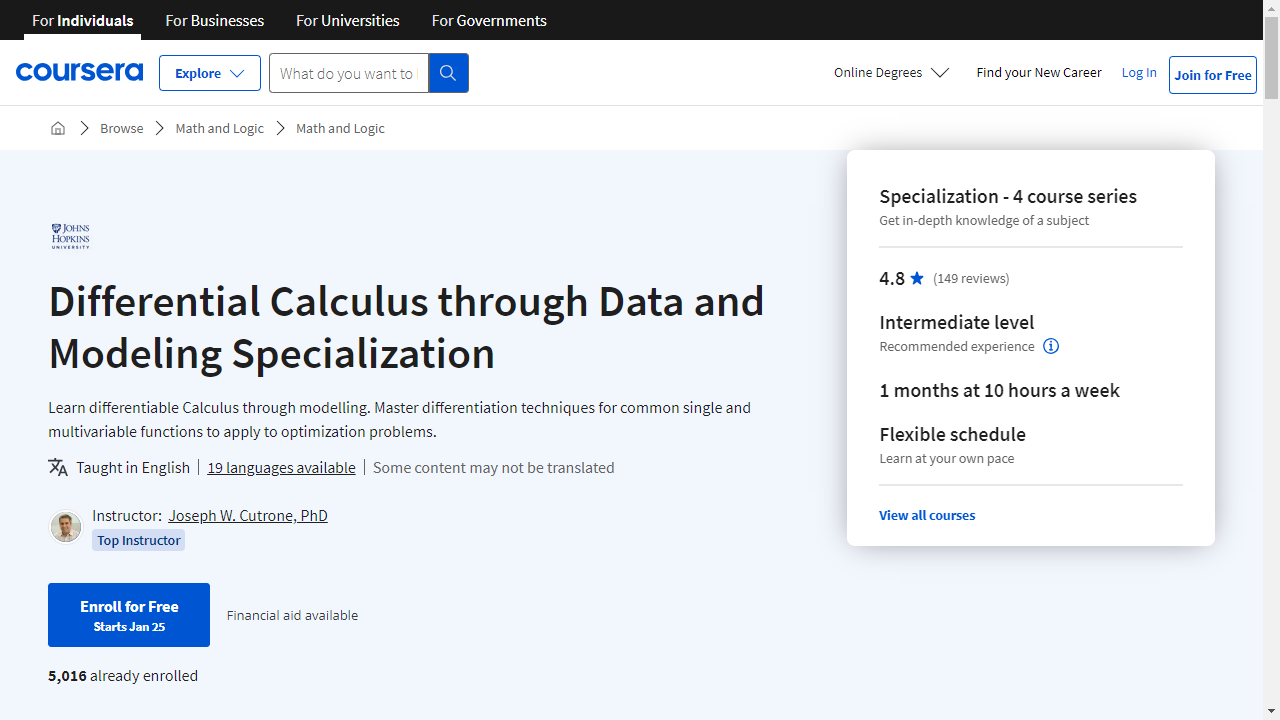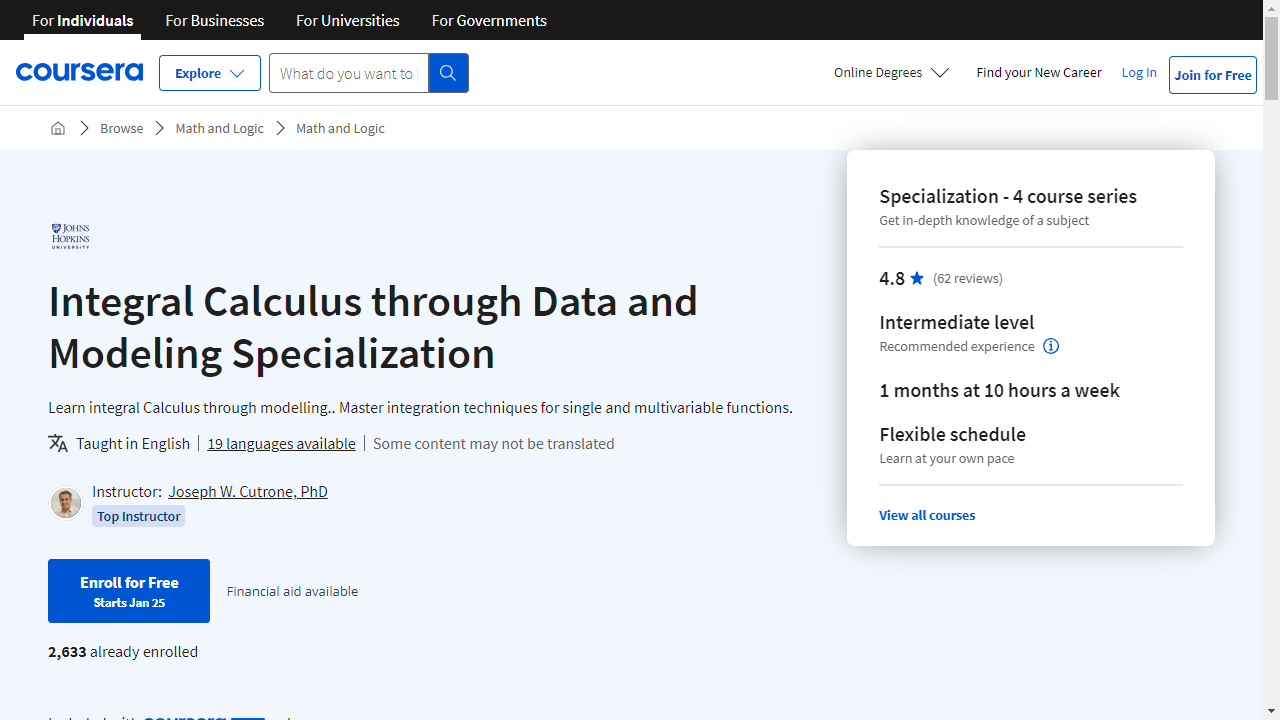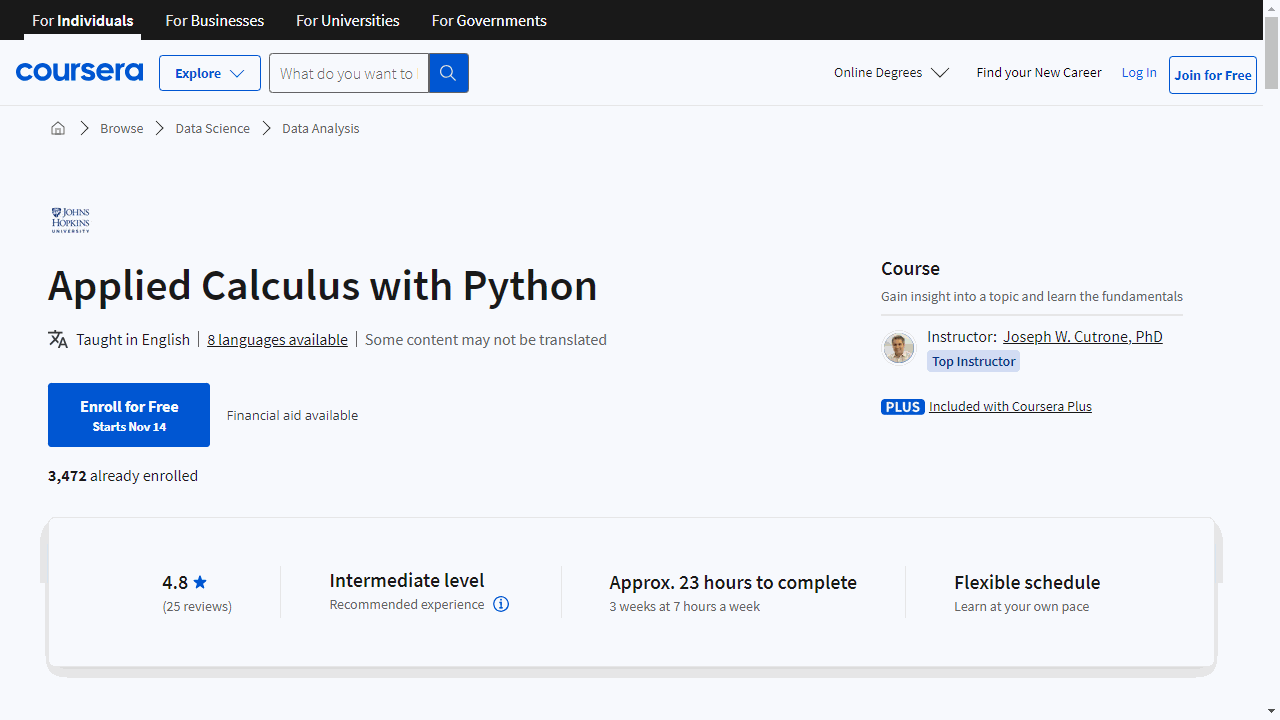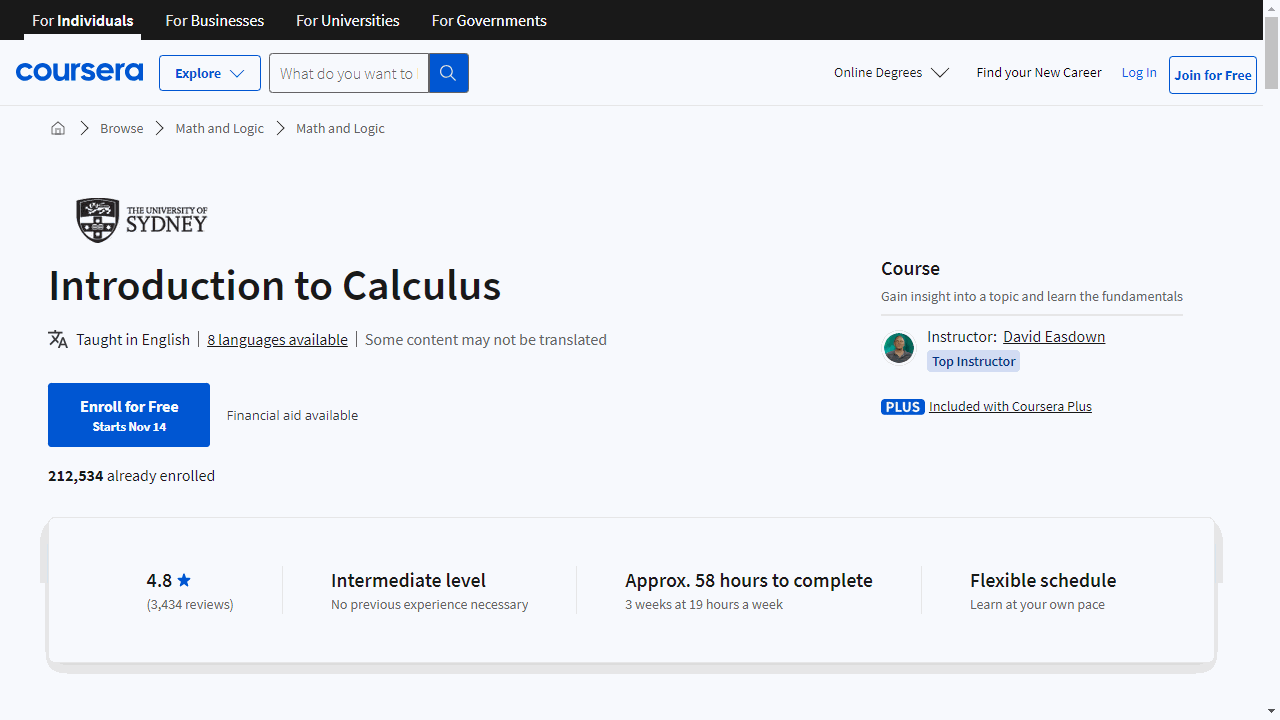Calculus is a foundational branch of mathematics that explores concepts like rates of change, accumulation, and motion.
It’s an essential tool for understanding the world around us, with applications in fields ranging from physics and engineering to economics and biology.
By mastering calculus, you can unlock a deeper understanding of these disciplines and gain valuable problem-solving skills applicable to a wide range of careers.
However, finding a truly effective calculus course can be challenging.
You’re looking for a course that not only covers the fundamental concepts but also provides clear explanations, engaging examples, and plenty of practice opportunities to solidify your understanding.
You want a course that’s both comprehensive and accessible, regardless of your prior mathematical background.
Based on our in-depth analysis, we believe Become a Calculus 1 Master on Udemy is the best calculus course overall.
This comprehensive course provides a thorough introduction to calculus, starting with the basics and gradually building up to more advanced topics.
It features clear and engaging video lectures, interactive quizzes, and practice exams to ensure you grasp the concepts effectively.
While Become a Calculus 1 Master is our top pick, there are other excellent calculus courses available, catering to different learning styles and goals.
Whether you’re a beginner seeking a solid foundation or an advanced learner looking to delve deeper into specific areas of calculus, we’ve got you covered.
Keep reading to explore our recommendations and find the perfect calculus course to embark on your mathematical journey.
Become a Calculus 1 Master
Provider: Udemy
“Become a Calculus 1 Master” guides you through the fundamentals of calculus, starting with limits and continuity.
You will discover different techniques to find limits, like substitution, factoring, and the conjugate method.
You will also explore various types of continuity, such as jump, point, and infinite discontinuities, and learn how to apply the Intermediate Value Theorem.
The course then dives into derivatives.
You begin by understanding the definition of a derivative and then progress to mastering essential rules like the power, product, quotient, and chain rules.
You’ll even learn how to find derivatives of trigonometric, exponential, and logarithmic functions, and apply your knowledge to work with tangent and normal lines, implicit differentiation, and optimization problems.
Finally, you’ll discover how calculus is used in real-world scenarios.
You will delve into physics concepts like position, velocity, and acceleration, and explore economic applications like calculating marginal cost, revenue, and profit.
You’ll also investigate exponential growth and decay, including topics like half-life and Newton’s Law of Cooling.
The course concludes with a comprehensive final exam, complete with practice exams to solidify your understanding and prepare you to ace your own Calculus 1 exams.
Differential Calculus through Data and Modeling Specialization
Provider: Coursera
This specialization equips you with a strong foundation in calculus and its applications in data analysis.
You’ll start with a precalculus review, where you’ll brush up on essential functions like polynomials, exponentials, logarithms, and trigonometry.
This refresher will prepare you to dive into the core concepts of single-variable calculus: limits and derivatives.
You’ll learn how derivatives measure a function’s rate of change, similar to how velocity measures an object’s speed.
The course then introduces differentiation rules, offering efficient ways to find derivatives of various functions, including polynomials, rational functions, exponentials, and trigonometric functions.
You’ll then apply these rules to solve problems related to rates of change and function approximations.
Finally, you’ll discover how to apply these concepts to real-world scenarios.
You’ll learn to use derivatives to understand a graph’s shape, find linear approximations for functions, and locate the maximum and minimum values of a function.
These optimization techniques prove invaluable for tackling real-world problems across diverse fields like machine learning, business, and science.
Ultimately, this specialization equips you with the knowledge and tools to apply calculus concepts in various practical settings.
Become a Calculus 2 Master
Provider: Udemy
This Calculus 2 course equips you with the tools to master intricate calculus concepts and their real-world applications.
You begin with the building blocks of integrals, learning how to calculate the area under a curve using antiderivatives and both definite and indefinite integrals.
You then explore various techniques for approximating areas, including Riemann sums, the midpoint rule, the trapezoidal rule, and Simpson’s rule.
You also delve into the concept of error bounds to ensure the accuracy of your approximations.
The course then introduces you to the Fundamental Theorem of Calculus, a pivotal concept that establishes the relationship between derivatives and integrals.
You’ll learn techniques like u-substitution, integration by parts, partial fractions, trigonometric integrals, and trigonometric substitution, expanding your ability to solve even more complex integrals.
The course doesn’t shy away from challenging concepts like improper integrals, where one or both limits of integration are infinite, and explores concepts of convergence and divergence.
You then move beyond the theoretical and dive into the practical applications of integrals across various fields.
You learn to calculate the area between curves, determine the length of a curve using arc length, find the average value of a function, and calculate the volume of solids of revolution.
The course illustrates how integrals are used in physics, covering concepts like work, hydrostatic pressure, and force.
You also discover how calculus applies to problems in economics, geometry, biology, and probability.
The course then shifts focus to parametric curves and polar curves.
You learn to manipulate these curves, converting between different forms, and apply calculus to find areas, arc lengths, and surface areas of revolution.
Finally, you delve into the world of sequences and series, understanding their properties, calculating their terms, and determining their convergence or divergence.
You explore different types of series like geometric series, telescoping series, and power series, and you utilize various convergence tests like the comparison test, limit comparison test, ratio test, root test, and alternating series test.
The course culminates with Taylor series and Maclaurin series, demonstrating how to use them for estimations.
Integral Calculus through Data and Modeling Specialization
Provider: Coursera
This specialization provides you with a strong foundation in integral calculus and demonstrates its use with real-world data and modeling.
You will start with fundamental concepts like sequences, series, and integration, which are key to understanding how quantities accumulate over time.
You will then use these tools to examine trends in areas ranging from finance to population growth.
You will explore the Fundamental Theorem of Calculus in the first course.
This theorem establishes a connection between differentiation and integration.
With this understanding, you will develop techniques of integration in the second course.
This is where you will learn to work with multivariable functions and vector functions, preparing you for vector calculus.
You will also discover how to approximate definite integrals using discrete data, an essential skill for real-world applications.
The third course delves into various applications of integration, covering concepts like average value, arclength, curvature, and velocity.
Through projects in this course, you will work with these concepts by analyzing and modeling real-world data.
The final course, Vector Calculus, focuses on integrating vector-valued functions, also known as vector fields.
You will learn about line integrals, which help calculate the work done by a force along a path.
You will also learn Green’s Theorem, which connects line integrals to double integrals.
Finally, you will use the Shoelace Theorem, a practical application of Green’s Theorem for polygons, in a data analysis project.
Become a Calculus 3 Master
Provider: Udemy
This Calculus 3 course thoroughly explains the essential concepts you need to master the subject.
You begin by exploring three-dimensional coordinate systems, where you learn to plot points and calculate distances in 3D space.
You also learn how to sketch graphs and level curves, a skill that helps visualize multivariable functions.
You then delve into the core of multivariable calculus: partial derivatives.
The course guides you through calculating first and second-order partial derivatives, applying the chain rule, and using implicit differentiation.
You discover directional derivatives, which reveal the rate of change of a function in a specific direction.
You also learn about gradient vectors and use them to determine the equation of the tangent plane and normal line to a surface.
The course then explores optimization, a technique for finding maximum and minimum values of multivariable functions.
You’ll learn to identify critical points, apply the second derivative test, and work with Lagrange multipliers to solve constrained optimization problems.
Real-world applications bring these concepts to life.
For example, you might learn how to calculate the maximum volume of a box contained within a sphere.
You then transition to multiple integrals, starting by approximating them with techniques like Riemann sums and the midpoint rule, ultimately progressing to exact calculations.
Applied Calculus with Python
Provider: Coursera
This course starts with the basics of Python, a versatile programming language perfect for math.
You will use a library called SymPy to easily work with and solve mathematical expressions within Python.
You’ll discover interesting calculus topics like functions – learning about different types like exponential and logarithmic functions, how to graph them, and even how to find their compositions.
To make this learning interactive, you’ll build an interactive quadratic calculator.
Next, you’ll dive into the world of limits – how to find them, including those involving infinity, and one-sided limits.
You’ll use Python to calculate limits, making the process smoother.
This leads into the key concept of derivatives – learning how to find them using limits and understanding their relationship with the slope of a tangent line.
You’ll explore higher derivatives, understand their impact on the shape of a graph, and even learn to build a local extrema calculator.
The journey continues to the fascinating concept of integration, learning to calculate areas under curves using both approximate and exact methods.
You will unravel the fundamental theorem of calculus, which links differentiation and integration, allowing you to solve a variety of calculus problems.
You’ll solidify your understanding with worked examples, cementing the knowledge gained throughout the course.
Calculus 1 with the Math Sorcerer
Provider: Udemy
This course begins by building a solid foundation in limits, a fundamental concept in calculus.
You will learn how to work with limit notation, calculate limits from graphs, and tackle more complex limit problems involving various function types like rational functions and piecewise functions.
You will even dive into the Squeeze Theorem, a handy technique for determining limits that can’t be directly calculated.
The course also explores the rigorous world of delta-epsilon proofs, solidifying your understanding of limits with formal mathematical reasoning.
Next, you will explore the concept of continuous functions.
This includes learning how to identify different types of discontinuities and understanding their impact on functions.
You will become familiar with the Intermediate Value Theorem, a critical concept in calculus.
You will then move on to derivatives, often considered the heart of calculus.
Starting with the fundamental definition of a derivative, the course guides you through various differentiation techniques, including essential rules like the product, quotient, and chain rules.
You will not only learn these rules but also apply them to solve real-world problems such as finding horizontal tangent lines and analyzing velocity and acceleration.
The course delves into the practical applications of derivatives, including implicit differentiation for finding derivatives of implicitly defined functions.
You will learn how to calculate the equation of tangent lines and tackle related rates problems.
You will explore concepts like extrema, where you’ll learn to find the maximum and minimum values of functions using tools like the Extreme Value Theorem and the Mean Value Theorem.
Building upon your knowledge of derivatives, you will then venture into the world of integrals – the reverse process of differentiation.
You will learn about indefinite and definite integrals, mastering the Fundamental Theorem of Calculus, which connects these two branches of calculus.
You will explore integration techniques, including the essential integration by substitution, and learn how to apply integrals to real-world scenarios, such as finding the area under a curve.
Introduction to Calculus
Provider: Coursera
This course gives you a strong foundation in calculus by starting with the basics of algebra and geometry.
You will learn about the real number line, decimals, and the Pythagorean theorem.
You will then explore algebraic expressions, inequalities, and coordinate systems.
These concepts are essential for understanding more advanced calculus topics.
You will then dive into the world of functions, learning about different types, including polynomial, exponential, and trigonometric functions.
You will also discover how to combine functions and find their inverses, which are crucial elements in calculus.
For example, you will use the unit circle to calculate sine, cosine, and tangent.
The course then moves into the core of calculus, covering derivatives and integrals.
You will learn how to calculate the slope of a tangent line, find the area under a curve, and understand the Fundamental Theorem of Calculus, which connects these two concepts.
Mastering these concepts will equip you to solve real-world problems, including understanding the escape velocity of a rocket.
You will even learn specialized techniques, such as integration by substitution, and how to apply essential rules like the Chain Rule, Product Rule, and Quotient Rule.
Also check our posts on:








